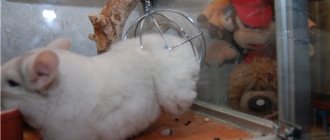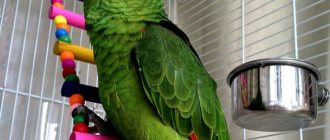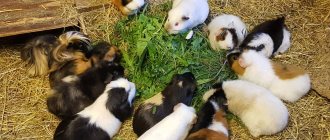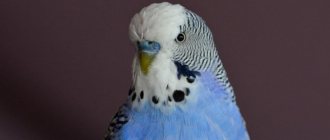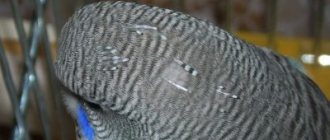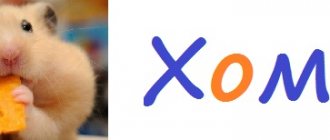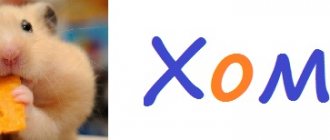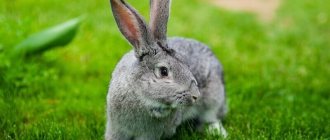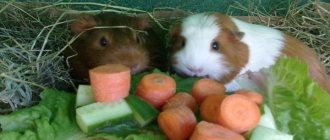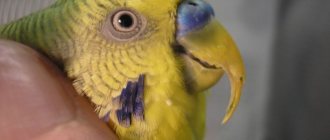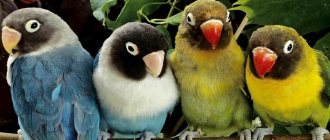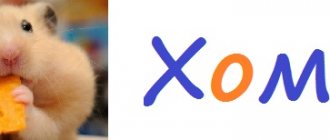How comfortable and safe the bird will feel depends on the correct arrangement of the cage for the wavy. It is important not only to choose the right cage size, but also to buy a feeder with a drinker.
Experienced breeders recommend installing two feeders at once, since one is intended for dry grain mixtures, and the second is used for fruits, vegetables or berries. Feeders are made from different materials, and also differ in size and other parameters, so you need to choose the product wisely.
Main types of feeders
Manufacturers of pet products regularly come up with new and unusual items that can be used by pets. Pet stores offer a huge selection of feeders for budgies, which differ in size, material, design, color, and even the method of fixation to the cage.
Feeders can be installed not only inside the cage, but even outside, but this option is only suitable for birds that live in an open cage, so they can go outside at any time.
Internal hinged
They are attached to the cell walls using wire or other means of fixation. Usually the lower perch is chosen for these purposes. Such products are made from different materials:
Plastic. Feeders made from this material are affordable and are also purchased for small parrots. The material is safe for parrots, and the product is easy to care for. Non-toxic plastic is used for animals, so even if the pet bites parts of the feeder, it cannot harm itself. It is advisable to choose models with wire fastenings, as they can be easily attached to the cage wall. It is not recommended to choose plastic products for large parrots, which will quickly chew through plastic.- Iron. Stainless steel is used to make these feeders. These models are suitable for all parrots, but before installation it is recommended to treat them with boiling water for disinfection. Even when exposed to high temperatures, such products do not deform. They are usually sold complete with convenient hooks or clips, with which the product is fixed to the wall of the cage.
- Porcelain. Such feeders are attractive in appearance and therefore have a decorative function. They take up a lot of space, so they are used in large cages. Often such products are painted, and the paint peels off after a few months, and it can also be dangerous for the parrot.
When choosing a feeder, its size and safety of use are taken into account, so it is advisable to abandon products that are painted.
What food do you give your parrots?
I make it myself from the store
External hinged
They are considered convenient to use because they do not take up space inside the cage. It is especially important to buy such a feeder for a timid pet who is afraid when a person puts his hand into the cage. The process of cleaning and filling the feeder is done from the outside.
The product is fixed to the cell wall, but it has some significant disadvantages:
- not suitable for all cages, so it is important to decide in advance on the dimensions and methods of fastening;
- some curious wavy animals easily open the lock on the lid, which allows them to get out of the cage;
- if the feeder is not too large, then the bird can climb into it, but will not be able to get out, which leads to suffocation if there are no people at home who can help the wavy.
External hanging products must be large in size so that the bird can turn around in them.
Floor-standing
They are not considered very popular as they take up a lot of space at the bottom of the cage.
They have significant weight so that the bird cannot turn them over. Some ornithologists claim that with the help of floor feeders, the activity of birds increases and also reduces aggression , since the wavy birds concentrate on turning the product over, which leads to a waste of energy.
The floor design is ideal for a sick bird that cannot maintain balance on a perch and therefore spends all its time at the bottom of the cage.
The disadvantages of such products include their rapid contamination, so a large amount of droppings and feathers accumulate in them in a short period of time. Therefore, it is advisable to install them not in the middle of the bottom, but to the side.
Rotating
They are not only intended to feed the parrot, but also contribute to its development . They are suspended from the ceiling of the cage, and are also located in such a way that the parrot has constant access to them.
During feeding, the feeder begins to rotate, and there are walls along the edges, so the bird must make an effort to reach the food. Such actions are associated with the pet's play and development.
Automatic
In another way, such feeders are called bunker feeders. The principle of operation is gravity, so as soon as the bird eats the food, a small amount of grain is poured from the upper reservoir into the container intended for food.
Thanks to this device, the food is located in a closed container, so it does not become dirty. It is very convenient to use such a feeder if you need to leave for several days.
There are two types of automatic feeders:
- Open. In such a product, the bowl intended for food is not protected from above, so sometimes droppings and fluff get into it.
- Closed. They are covered with a plastic lid on top, so the food does not become dirty. Such models are completely safe, but it is impossible to control how much food your pet eats per day.
Automatic products are quite expensive.
External hinged
There are plastic feeders on sale that are attached to the outside of the cage. For them, a special “window” must be provided in the cage so that the parrot can get to the food. Such designs are convenient because they do not take up space in the bird’s house, and at the same time they allow you to change food outside without disturbing the pet.
This feeder also has disadvantages:
- it is difficult to find a model for your cage if they have different manufacturers;
- if the outer lock is weak, the bird can get out;
- when removing dishes for washing, the window remains open;
- Small feeders with a narrow entrance are very dangerous: a parrot, having climbed all the way there, can get stuck and even suffocate.
How to make it yourself
Many wavy owners prefer to make a feeder themselves, using safe materials. This allows you to get a product that has the necessary parameters, and it can also be decorated with various decorative elements. You don’t have to spend a lot of money and time on making such a product.
To create a feeder, the following materials are prepared:
- plastic bottle;
- wooden spoons;
- glue;
- nails and sandpaper;
- scissors;
- stationery knife;
- wire;
- jigsaw;
- glass or ceramic cup or bowl.
To make a product intended for wavy, only safe wood species are used, for example, raspberry or apple tree.
Initially, a decision is made on the size and shape of the future feeder, for which the features of the prepared materials are taken into account. If you use a glass jar that was previously used for food, then it is first washed and also doused with boiling water. It is attached to the cell wall with ordinary wire. The same actions are performed with a coffee cup.
If a plastic bottle is used to create a feeder, then a small hole is made in it through which the bird can access food. Additionally, small holes are made for wire. When creating sections, even small burrs are removed, and the lower edge, which the wavy will touch, is glued with an adhesive plaster.
Another option involves using wooden spoons. To do this, holes are made in a plastic bottle into which spoons are fixed. This design is similar to an automatic feeder, since the grains move into the spoon as it is released.
Even plastic bottles need to be disinfected, but if boiling water is used for this, you should not expose the product to it for too long, as this will lead to deformation.
The photo shows one of the options for feeders, made by yourself:
Another option for making a feeder with your own hands in the video:
Choosing the right size
First of all, when you come to the store to buy goods for birds, you should choose housing. What size cage is suitable for a budgie? On the one hand, the answer is simple - the more, the better. It is desirable that the bird can fly freely in the cage. On the other hand, installing a full-fledged enclosure in a room, allocating a few square meters, is very wasteful. Most breeders simply cannot afford this luxury.
Therefore, we have to look for a certain compromise. If you decide to have one parrot, then it is advisable that the cage be at least 25 x 60 centimeters in size. In this case, at least one indicator must exceed half a meter. Then the bird will be able to fly a little and give stress to its wings. In small cages, parrots usually use only their legs to move around. Because of this, the load on the body decreases and the risk of developing obesity, which can lead to premature death, increases.
For a pair of budgies you will have to increase the size - at least 50 x 60 centimeters. Thanks to this, both your pets will be able to stretch their wings a little without disturbing each other. But high altitude, contrary to the opinion of many amateurs, is not very important - parrots will not be able to fly strictly up and down. Therefore, you should not place much emphasis on height - 30–40 centimeters is quite enough, or less.
Types of bird drinkers
In addition to the feeder, the cage should have a drinking bowl with clean and fresh water. Without water, wavy birds quickly die, so the owner must monitor its constant presence. Pet stores offer several types of drinking bowls:
- Open. They have an affordable price and a simple design, but the water in them is constantly contaminated, which includes feathers, food debris and pieces of fruit. Some wavy fish deliberately throw their food into it. If such a drinking bowl is large, then it can be used for bathing the bird. The water has to be changed several times in one day.
- Closed. They are often chosen by experienced breeders because the water in them remains clean for a long time. They are made of plastic or glass. The water has to be changed daily.
- Automatic drinking bowls. Such products are considered the most hygienic for budgies. They are available in different sizes, so you can choose the product that is ideal for a particular cage. They are fixed outside or inside the cell. The advantages of using them include protection from pollution, and in summer the water evaporates extremely slowly.
Usually, birds quickly understand what this or that accessory is for, so there is no need to accustom them to the drinking bowl. But if the chick cannot drink water from an automatic drinker equipped with a ball, then you need to install the product next to the perch, and also periodically press the ball with your hand so that water flows.
If the bird is not yet accustomed to humans, then it is advisable to mount the drinking bowl near the exit from the cage so as not to disturb the parrot while changing the water.
Automatic
They are divided into open and closed.
Open
Automatic open type feeders are also called buffer feeders. Their operating principle is based on gravity. Food is poured into the body, which is fed through a small hole into the plate gradually as it is eaten. They are easy to maintain and extremely convenient for those parrot owners who are constantly busy. They do not need to frequently add food, which is always clean, since the husks immediately go into a special compartment.
But there are also serious disadvantages. Automatic feeders make sounds that frighten other pets so much that they do not touch the food, even when very hungry.
In addition, the mechanism may break down and stop working with all the ensuing consequences.
Closed
Closed automatic feeders for parrots are very practical and reliable. They completely eliminate the possibility of contamination by waste and bird droppings. This means that they are the safest for the parrot.
Tips for choosing
When choosing a drinker or feeder, simple tips are taken into account:
- the material from which accessories are made must be safe;
- It is not advisable to buy painted products, as the paint will begin to peel off and therefore may be swallowed by a bird;
- the product must correspond to the size of the bird;
- its fastenings must be suitable for a specific cage.
If your pet doesn't like a certain product, it will have to be replaced.
Hygiene issues
It is important to keep feeders and drinkers clean to prevent the growth of bacteria. It is recommended to wash the main dishes for grain feed with hot water every time you change feed and disinfect them with boiling water at least once a week. For disinfection, soda solution or chamomile infusion is also used.
The second feeder for mineral supplements is washed at least once every two weeks. If you notice droppings on it, it is advisable to clean it immediately.
Every six months, it is recommended to replace food and water dishes with new ones. And, of course, do not forget about maintaining cleanliness in the cage: the health of your pet directly depends on this.
Choosing the right feeder for your parrot is not difficult if you do your research in advance. In addition, you can always observe the behavior of the bird, understand whether he likes this item, and replace it with another. It is important not to forget about the safety of the bird and buy quality items.
Source
Fruit holders
Wet food for budgies is not limited to cereals or purees - sometimes it is worth pampering and keeping your pet occupied with a slice of fruit or a piece of vegetable. The parrot can pick up small pieces in its paw if it is dexterous enough, but this way the food spoils faster and stains the bird. If large pieces are squeezed between the bars of the cage, this will quickly lead to their oxidation and fall. To maintain the aesthetics of the cage and to prevent food from falling into the litter, special fruit holders are created, usually presented in the form of a rod with a limiter and fasteners for hanging. Please note that the rod must be made of stainless materials - copper, zinc, brass, bronze and other metals quickly oxidize and can lead to the death of the bird. Some owners use a small plastic mounting clip to secure treats.
On sale you can find clips, rods, holders for twigs, chumiz and herbs with a through hole, as well as forage toys that can keep the bird busy with the extraction of goodies. Fruit holders usually come in one model for birds and for rodents.
What to do if your parrot does not drink water from the drinking bowl
Parrots do not require much moisture, so it may often seem that the pet is not drinking at all. If the diet includes juicy fruits and vegetables, then the parrot's drinking bowl can also remain untouched all day. But usually the bird still drinks water, although this happens so quickly and rarely that the owners simply do not have time to notice. To eliminate doubts, you can mark the water level on the side with a pencil or marker - by evening it will be noticeable whether there are any changes.
Sometimes a pet really refuses water, the reasons can be different - stress when moving, illness, even aversion to the strong smell from a new plastic device. In this case, dehydration will inevitably affect the appearance of the bird - sunken eyes, slightly sagging skin on the legs, dirty and ruffled feathers. The bird will behave sluggishly, freeze and hide its head under its wing.
It is important to remember that birds have an accelerated metabolism; they cannot go without food and water for long. Therefore, if a parrot does not want to drink water from a drinking bowl, it is better to determine the exact reason for this behavior as soon as possible. Even one day without water can cause serious harm to your parrot's health, so if symptoms of dehydration are present, you should contact your veterinarian as soon as possible.
Even one day without water can cause serious harm to your parrot's health, so if symptoms of dehydration are present, you should contact your veterinarian as soon as possible.
Correct placement of objects
Now let's talk specifically about how to equip a cage for a budgie.
Let's start with the fact that the perches should be located at some distance from each other - so that the bird has to use its wings when flying. This will keep her on her toes all the time.
It is also very important not to place the perches under each other. Otherwise, one pet, sitting above, may well stain its neighbor, located below, with droppings.
It is advisable to place feeders, drinkers, sepia and mineral stone further away or higher than the perches. Then the risk of contamination by the same droppings is reduced.
Mineral feeding
Liquid vitamin and mineral supplements carry a risk of overdose, so they are usually prescribed by an ornithologist - for emergency assistance or for a short period of up to a month. The main feeding is usually sepia or a mineral mixture, which is available in the form of compressed stone or organic sand.
Sepia, or cuttlefish shell, is the best and most easily digestible source of calcium for budgies. The content of this valuable element in it exceeds 37%. In addition, it does not have the main disadvantages of raw eggshells - it does not require additional processing and cannot be contaminated with salmonellosis. But be careful: the cuttlefish bone should not be salted or painted in bright colors. Its natural color is white or ivory. Sepia is easily attached to the bars of the cage and has no contraindications for use, and also helps the bird to grind down its beak. Some parrots need to be trained to eat it, but most will happily nibble it themselves. The sepia is quite soft and the wavy handles it easily. And the content of phosphorus, sodium and magnesium makes it a very valuable supplement. Moreover, sepia is actually the only mineral supplement allowed when feeding chicks. But it is not recommended to grind it and sprinkle it on wet food - firstly, it reacts with fruit juices, and secondly, there is a risk of overdosing the fertilizer, which often leads to kidney problems and metabolic disorders.
Feeding birds is especially important during the period of molting and feeding chicks - then the need for minerals can increase 3 times! A deficiency of calcium and phosphorus in the diet of budgerigars leads to the death of offspring, fragility of the beak and bones, fragility of plumage, diseases of the thyroid gland, and in the most advanced cases, to convulsions and death.
Blue clay, shell rock, coral, chalk, and ground eggshells are used as alternative sources of calcium or mineral stone ingredients. When adding charcoal to the mixture, please note that it greatly reduces the acidity of the stomach and in large quantities can lead to digestive problems. The normal amount of mineral mixture for wavy is no more than 2 tsp. in Week. If the norm is exceeded, you should contact an ornithologist.
River (quartz) and other inorganic sand is extremely dangerous for parrots and can clog the bird’s crop. Construction chalk and rodent chalk are deadly toxic to wavy birds.
Remember that, contrary to popular myth, parrots do not need gastroliths and are excellent at grinding grain with their beaks!
Where to install the cage
Having told you how to set up a cage for a budgie, you should definitely mention the place where it is best to install it. Or rather, about the places where it should not be installed.
She definitely doesn't belong in the kitchen. Still, droppings and sometimes flying fluff create unsanitary conditions, which are unacceptable in the room where food is prepared.
It is also best to keep the cage away from the window. In summer, the bird will suffer from overheating due to direct sunlight. And in winter, the glass usually gives off cold, which can harm the parrot. And this is not to mention the drafts and simply frosty wind that arise when the window is opened to ventilate the room.
Finally, you should not place the cage in a place where there is at least occasional smoking. Parrots are very sensitive to tobacco smoke. Even a rare role as a passive smoker will cause serious harm to your pet.
Useful little things
Also, when choosing a cage, you need to pay attention to a few little things. For example, doors should open easily and close tightly. Moreover, it is advisable to give preference to swing ones rather than lifting ones.
The fact is that parrots are generally distinguished by their ingenuity. They are quite capable of opening simple latches, deftly using their claws and beak. And then lift the door to get out. Unfortunately, it is precisely at this moment that the lifting mechanism often falls, and if it hits the neck, it pinches the bird’s head. Usually the parrot can no longer lift it and simply tries to escape, receiving serious wounds. A swing door is much safer in this regard.
We should not forget about the pallet. Be sure to choose a cage with a retractable product. It is very easy to clean - just pull it out, shake out the accumulated debris and rinse with warm water. If there is no retractable tray, then you will have to remove debris with a vacuum cleaner or manually, and then wash the bottom with a damp sponge - a much more difficult job that takes much more time.
A little about perches
As mentioned above, you can make wooden perches yourself. But to figure out how to set up a cage for a budgie, it is very important to know what raw materials are suitable. In general, any wood can be used, except for a few varieties:
- containing toxic substances (acacia, poplar, lilac);
- which contain tannins (cherry, oak, pear);
- conifers containing resin.
You can simply use a branch that is not too thick (about 1.5–2 centimeters in diameter) - this is the easiest way. Before installing the wood in the cage, it must be doused with boiling water and wiped dry.
